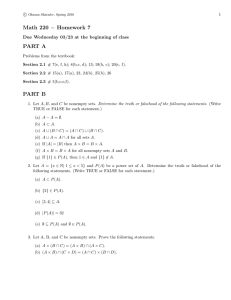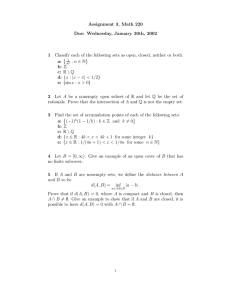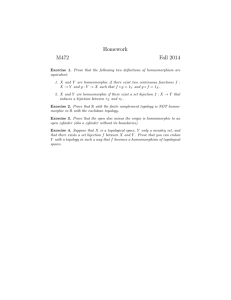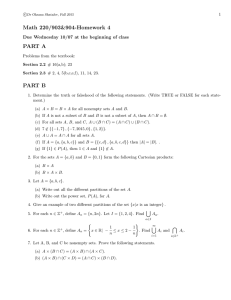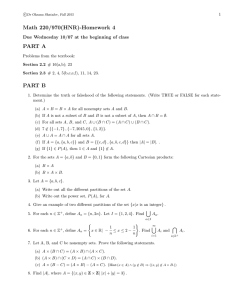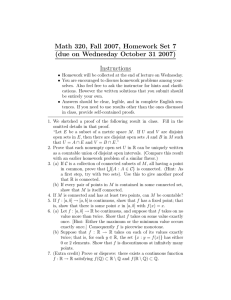MAT 364 - Homework 7 Solutions to Selected Exercises
advertisement
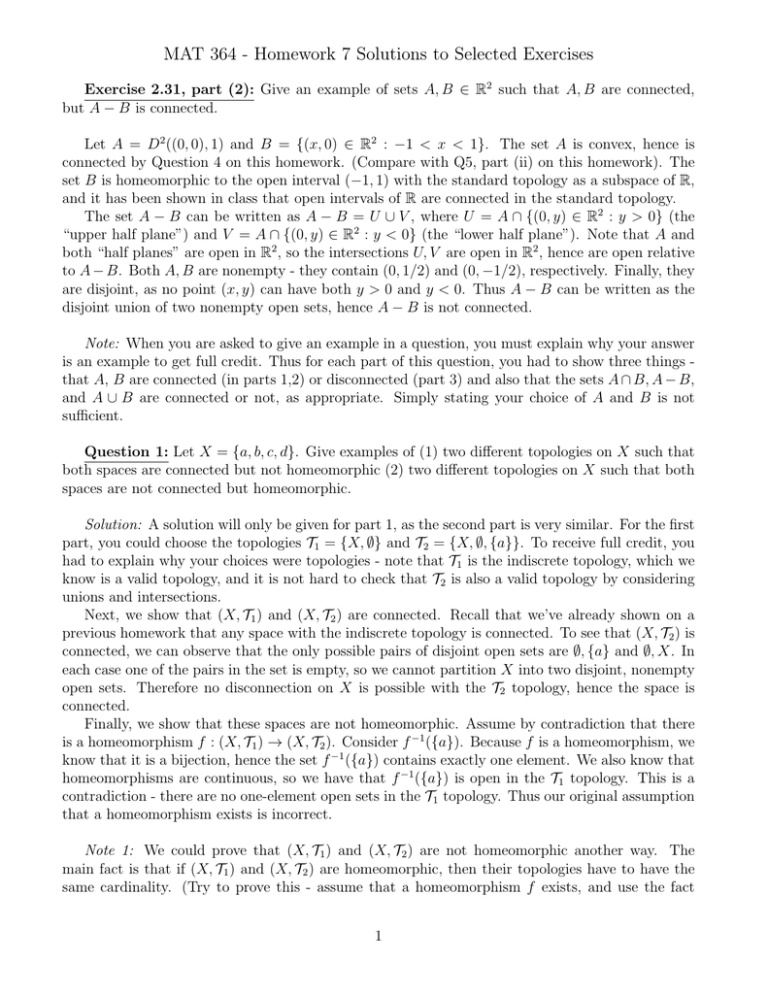
MAT 364 - Homework 7 Solutions to Selected Exercises
Exercise 2.31, part (2): Give an example of sets A, B ∈ R2 such that A, B are connected,
but A − B is connected.
Let A = D2 ((0, 0), 1) and B = {(x, 0) ∈ R2 : −1 < x < 1}. The set A is convex, hence is
connected by Question 4 on this homework. (Compare with Q5, part (ii) on this homework). The
set B is homeomorphic to the open interval (−1, 1) with the standard topology as a subspace of R,
and it has been shown in class that open intervals of R are connected in the standard topology.
The set A − B can be written as A − B = U ∪ V , where U = A ∩ {(0, y) ∈ R2 : y > 0} (the
“upper half plane”) and V = A ∩ {(0, y) ∈ R2 : y < 0} (the “lower half plane”). Note that A and
both “half planes” are open in R2 , so the intersections U, V are open in R2 , hence are open relative
to A − B. Both A, B are nonempty - they contain (0, 1/2) and (0, −1/2), respectively. Finally, they
are disjoint, as no point (x, y) can have both y > 0 and y < 0. Thus A − B can be written as the
disjoint union of two nonempty open sets, hence A − B is not connected.
Note: When you are asked to give an example in a question, you must explain why your answer
is an example to get full credit. Thus for each part of this question, you had to show three things that A, B are connected (in parts 1,2) or disconnected (part 3) and also that the sets A ∩ B, A − B,
and A ∪ B are connected or not, as appropriate. Simply stating your choice of A and B is not
sufficient.
Question 1: Let X = {a, b, c, d}. Give examples of (1) two different topologies on X such that
both spaces are connected but not homeomorphic (2) two different topologies on X such that both
spaces are not connected but homeomorphic.
Solution: A solution will only be given for part 1, as the second part is very similar. For the first
part, you could choose the topologies T1 = {X, ∅} and T2 = {X, ∅, {a}}. To receive full credit, you
had to explain why your choices were topologies - note that T1 is the indiscrete topology, which we
know is a valid topology, and it is not hard to check that T2 is also a valid topology by considering
unions and intersections.
Next, we show that (X, T1 ) and (X, T2 ) are connected. Recall that we’ve already shown on a
previous homework that any space with the indiscrete topology is connected. To see that (X, T2 ) is
connected, we can observe that the only possible pairs of disjoint open sets are ∅, {a} and ∅, X. In
each case one of the pairs in the set is empty, so we cannot partition X into two disjoint, nonempty
open sets. Therefore no disconnection on X is possible with the T2 topology, hence the space is
connected.
Finally, we show that these spaces are not homeomorphic. Assume by contradiction that there
is a homeomorphism f : (X, T1 ) → (X, T2 ). Consider f −1 ({a}). Because f is a homeomorphism, we
know that it is a bijection, hence the set f −1 ({a}) contains exactly one element. We also know that
homeomorphisms are continuous, so we have that f −1 ({a}) is open in the T1 topology. This is a
contradiction - there are no one-element open sets in the T1 topology. Thus our original assumption
that a homeomorphism exists is incorrect.
Note 1: We could prove that (X, T1 ) and (X, T2 ) are not homeomorphic another way. The
main fact is that if (X, T1 ) and (X, T2 ) are homeomorphic, then their topologies have to have the
same cardinality. (Try to prove this - assume that a homeomorphism f exists, and use the fact
1
that it is bijective with f, f −1 continuous to show that it induces a bijection between the sets T1
and T2 ). In our example, we have that |T1 | = 2 and |T2 | = 3, so the topologies are not homeomorphic.
Note 2: We showed that no homeomorphism could exist, not just that a particular function is
not a homeomorphism. For example, one could show that the identity function is not a homeomorphism, perhaps by showing that it is not continuous. After showing this, though, it could still be
possible that some other homeomorphism could exist - perhaps the function that takes a 7→ b, b 7→ a,
and fixes c, d could be a homeomorphism. Instead of trying to analyze all of the possible functions
on X and check one-by-one that they are not homeomorphisms, we argue as above.
subsets of a topological space X. Assume
Question
3: Let {Uα }α∈A be a collection of connected
T
S
that α∈A Uα is not empty. Show that the union α∈A Uα is connected.
S
Solution: Assume by contradiction that U = α∈A Uα is not connected. That is, there exists
A, B ⊂ U such that A ∪ B = U , both sets are nonempty, A, B are disjoint, and A, B are relatively
open as subsets of U .
T
T
Because the intersection α∈A Uα is nonempty, there exists some point z ∈ α∈A Uα . Without
loss of generality, we assume that z ∈ A. Because B is nonempty, we can also pick some w ∈ B.
Now w ∈ U , so there exists some Uα such that w ∈ Uα since U is a union of the Uα . We also have
that z ∈ Uα .
Then let Ā = A ∩ Uα and B̄ = B ∩ Uα . Note that these sets are both nonempty, as z ∈ Ā and
w ∈ B̄. Both Ā and B̄ are relatively open in Uα , since they are the intersection of the open sets
A, B with Uα . Their union is
Ā ∪ B̄ = (A ∩ Uα ) ∪ (B ∩ Uα ) = (A ∪ B) ∩ Uα = U ∩ Uα = Uα
and their intersection is
Ā ∩ B̄ = (A ∩ Uα ) ∩ (B ∩ Uα ) = (A ∩ B) ∩ Uα = ∅ ∩ Uα = ∅
that is, Ā and B̄ are disjoint.
Thus we can write Uα as the union Uα = Ā ∪ B̄ of disjoint, nonempty open sets, so that Uα is
not connected. But this contradicts the hypothesis that all the Uα are connected. Therefore our
original assumption is incorrect, that is, the union ∪α∈A Uα is connected.
Question 4: Let W ⊂ Rn be a convex subset - that is, if x, y ∈ W , then the line segment
joining x to y in Rn is also contained in W . Show that W is connected.
Solution: Assume by contradiction that W is not connected. That is, there exists A, B ⊂ U
such that A ∪ B = W , both sets are nonempty, A, B, are disjoint, and A, B are relatively open as
subsets of W .
Because A and B are nonempty, we can choose points a ∈ A and b ∈ B, and let L be the line
segment joining those two points. Let Ā = A ∩ L and B̄ = B ∩ L. Using similar arguments as in
the previous problem, we can show that the sets Ā, B̄ are disjoint, nonempty subsets of W that are
relatively open in W . We also have that
Ā ∪ B̄ = (A ∩ L) ∪ (B ∩ L) = (A ∪ B) ∩ L = W ∩ L = L.
The last equality in the line above is where we use the fact that W is convex. Convexity gives that
L ⊂ W , and therefore W ∩ L = L.
2
Thus we can write L as the union L = Ā ∪ B̄ of disjoint, nonempty open sets, so that L is not
connected. But L is a line segment in Rn , hence homeomorphic to a closed interval in R, and we
know that closed intervals are connected. Thus L is connected, and we have a contradiction. Our
original assumption was wrong, and so W is connected.
Question 5: Determine with proof the connectedness of the the plane, the open disk, the plane
with a line or point removed, and the rationals in R.
Solution: For (i), (ii), which are R2 and the open disk D2 (x, r) in R2 , both with the standard
topologies, we can observe that both spaces are convex, hence connected by the previous question.
For (iii), we consider R2 with the x-axis removed. We can write this set as A ∪ B, where
A = {(x, y) ∈ R2 : y > 0} and B = {(x, y) : y < 0}, the upper and lower half planes. These sets
are clearly nonempty, disjoint, and open in R2 , hence open in R2 − {x − axis}, so we have that
R2 − {x − axis} is not connected.
For (iv), consider A, B the upper and lower half planes as defined above, and let C, D be the
“left” and “right” half planes, C = {(x, y) : x < 0}, D = {(x, y) : x > 0}. Each of A, B, C, D is
connected, as they are convex. Note that A ∩ C is nontrivial (it is the second quadrant in the plane)
so therefore A ∪ C is connected. Then (A ∪ C) ∩ B is nontrivial (the third quadrant in the plane)
so (A ∪ B) ∪ C = A ∪ B ∪ C is connected. A similar argument with D shows that A ∪ B ∪ C ∪ D
is connected, but this set is just R2 − {(0, 0)}, so the plane with the origin removed is connected.
For (v), let A = Q ∩ (−∞, α) and B = Q ∩ (α, ∞) for α an irrational number. Note that A
and B are easily seen to be disjoint, open in the relative topology on Q, and nonempty. We also
have A ∪ B = Q, as A ∪ B = (R2 − {α}) ∩ Q = Q since α is irrational. Thus we can write Q as the
nonempty disjoint union of two relatively open sets, so Q is not connected.
3
